German Mobile Firing Procedure
for A-4/V-2
(Photo stills taken from film Operation
Backfire)
-
 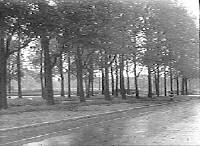 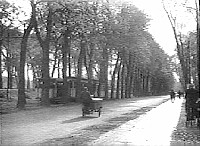
| The V-2 was launched from hidden
wooded areas or even vacated city streets. Seen above is the entrance
to
the Duindigt area in Wassenaar and a city street Stadhouderslaan in Den
Haag, 1945. |
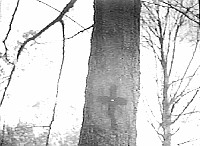 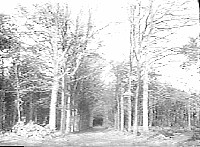 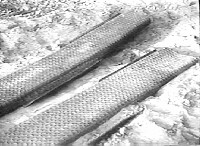
| Triangulation marks on trees, the
Duindigt Estate entrance, and steel sleepers used for launch table
stabilization. |
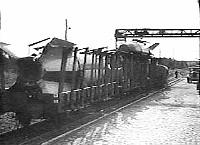 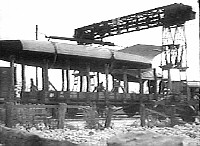 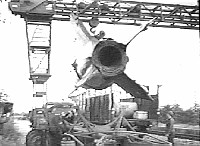
| Rockets arrive by railway, where
they are met by the Technical Troop at the transfer point. Two rockets
occupy
3 flatcars. The mobile crane is positioned to lift the rocket from the
flatcar to the Vidalwagen road transporter. |
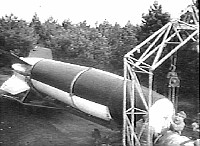 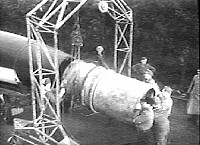 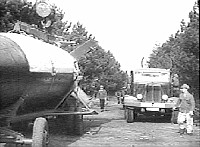
| The Technical Troop transports the
rockets to the field store where the warheads are attached and minor
adjustments
made. The field store was not usually in the vicinity of the firing
areas,
but some kilometers away. |
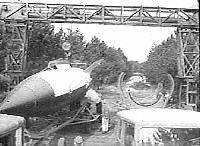 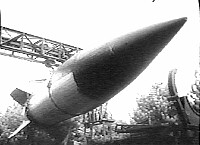 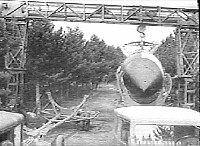
| The mobile crane is later towed
to a prearranged spot where the Technical Troop meets the Firing Troop.
This was usually done in another secluded location, so as to not draw
attention
to the field store or firing locations. The Vidalwagen pulls under the
crane, and the Meillerwagen pulls next to it. The V-2 is hoisted and
moved
to the Meillerwagen vehicle. |
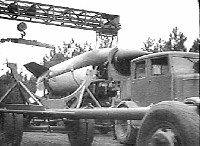 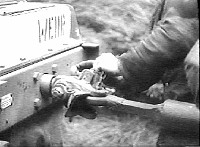 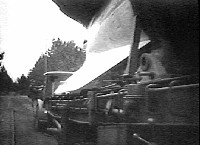
| With the rocket secured in the clamps
of the Meillerwagen, the Vidalwagen pulls away. The Meillerwagen is
hitched
to the towing vehicle, in this case a Hanomag SS-100, and then driven
to
the firing location. |
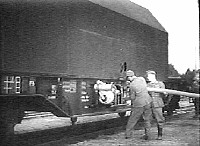 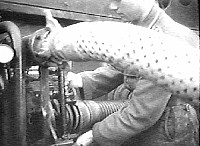 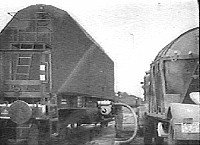
| Back at the railhead, the liquid
oxygen railway tanker is approached by members of the Supply
Detachment.
Using a small gasoline-powered engine to run an external pump, they
attach
the hoses and tow the Betriebstoffanhaenger liquid oxygen road tanker
alongside
the rail tanker. |
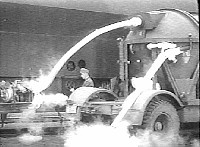 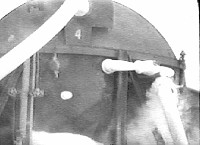 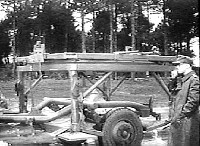
| The super-cooled liquid oxygen soon
creates frost on the hoses and attachments. The white vapor is exiting
condensed water vapor. Meanwhile, the Firing Troop tows the
Abschussplattform
(firing table) onto the launch site. |
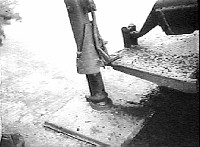 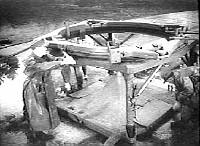 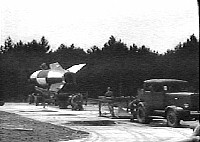
| The legs of the Pfaff-manufactured
Abschussplattform are screwed down to lift the weight of the platform.
The towing dolly is then removed. The dial-sight is adjusted, and then
the Meillerwagen is wenched backwards to the firing table. |
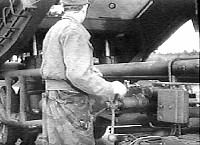 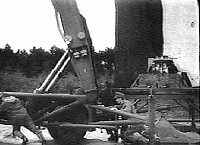 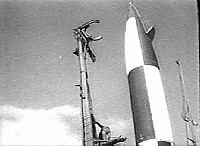
| The extending supports are swung
out and screwed down at the rear of the Meillerwagen for the support
needed
while raising the rocket. A small Volkswagen gasoline engine operates
(2)
hydraulic rams, which, are controlled by one man to raise the arm of
the
Meillerwagen into the vertical position. The Meillerwagen is then
rolled
back about 96 cm after the V-2 is resting upright on the
Abschussplattform.
Also shown is the electrical cable mast that is mounted at one corner
of
the Bodenplatte. These cables travel to the Feuerleitpanzer launch
control
vehicle and the Steyr power supply vehicle.. |
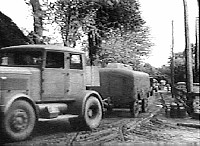 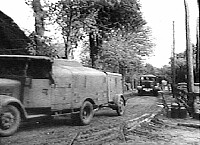 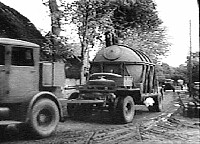
| Soon the Supply Detachment or Fueling
Troop was moving quickly to the location of the firing site. In this
case,
we see a Hanomag towing an alcohol bowser, followed by the Opel Blitz
alcohol
tanker towing a trailer pump, followed by a Hanomag towing the liquid
oxygen
trailer and finally, (the small truck in the distance) is the Opel
Blitz
t-stoff tanker. |
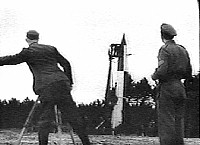 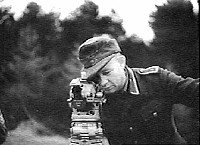 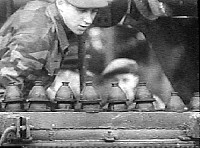
| At the firing site, the survey crew
is busy measuring to make sure the rocket is level. The protective
engine
jet covers are removed from the venturi in the combustion chamber. |
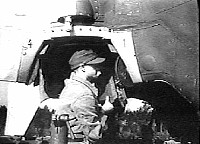 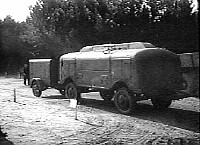 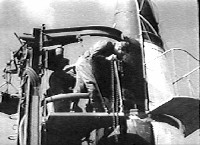
| The fragile carbon graphite exhaust
rudders are carefully bolted in place. Fueling started with the alcohol
bowser being pulled up to the rocket. The Meillerwagen arm was built to
also act as a servicing tower, with built-in plumbing for permanent
delivery
of alcohol and liquid oxygen when fueling. The hoses were connected to
the Meillerwagen at the tanker and at the top of the V-2 fuel tanks. |
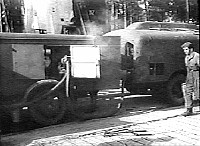 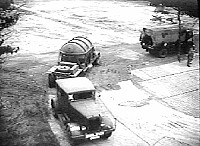 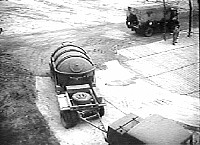
| The towed trailer pump in action.
Alcohol fueling took about 10 minutes. When alcohol fueling was almost
completed, the liquid oxygen tanker was towed to the other side of the
rocket. |
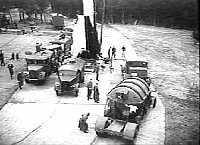 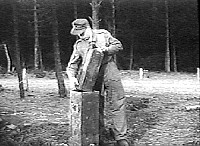 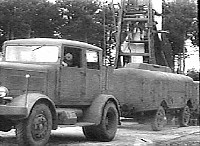
The bevey of vehicles surrounding
the V-2. Directly infront of the rocket is the t-stoff tanker (hydrogen
peroxide). The liquid oxygen was always pumped into the rocket no more
than one hour before firing to prevent the internal valves from
freezing.
The sodium permanganate was kept heated to quicken the reaction with
t-stoff
when powering the steam turbine. The alcohol bowser is finished and
pulls
away. This bowser shown was not used by the V-2 troops—it was a
Luftwaffe piece of equipment.
|
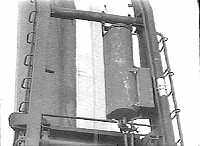 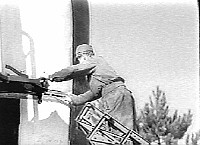 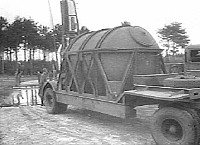
| During the liquid oxygen fueling,
the hydrogen peroxide is manually pumped into a pre-measured container
mounted to the Meillerwagen, which, is emptied into the t-stoff tank by
gravity. A technician climbs up to the midsection joint and adjusts the
tension created by 8 tons of added fuel. The z-stoff is removed from
its
heater, and emtied into the rocket manually. Fueling completed, the
liquid
oxygen tanker pulls away. |
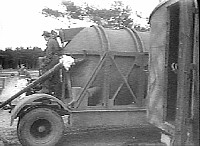 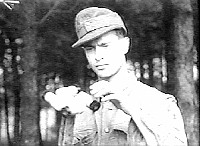 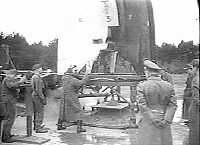
| The support vehicles retreat to
a safe distance. The igniter is prepared to be inserted in the
combustion
chamber and the rocket is oriented by using a dial sight on the
Abschussplattform.
The arm of the Meillerwagen comes down. |
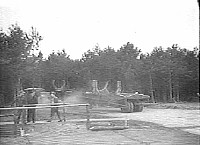 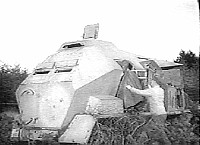 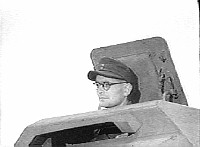
| Meillerwagen heads away from the
area. The members of the Firing Troop take cover in slip-trenches
prepared
earlier. The Feuerleitpanzer (Sd.Kfz.7/3) firing control vehicle is
located
about 100-150 meters away from the rocket, usually down in a protective
trench that was dug when the site was prepared. The launch control
officer
and crew enter the Feuerleitpanzer. Inside, the launch control officer
asks the man on the steeringtable, "Steuerung klar?"—"Steuerung
klar!"
is the answer. Everything is quiet. The soldiers are only whispering.
The
launch officer calls, "X1" (t-minus one minute). |
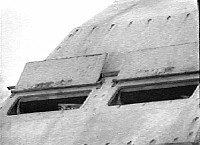 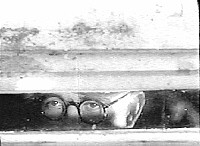 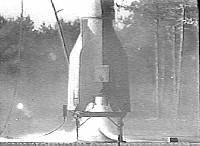
| The officer steps on a small perch
in the Feuerleitpanzer. He is able to see the launch site,
"Schlüssel
auf Schießen!," he orders. "Ist auf Schießen, Klarlampe
leuchtet!,"
says the man behind the propulsion controls. The fuel ignites, flowing
under gravity, burning at 1.5 to 2.5-tons of thrust. |
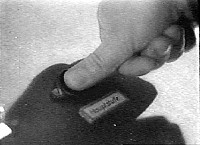  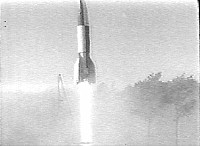
| After a precisely established sequence
of commands, the last order of the officer is barely heard over the
roar
of the engine, "Hauptstufe!" After that, the man at the propulsion
controls pushes the button and the fuel pumps and steam turbine begin
to
scream. The earth is shaking and vibrating under the pressure of
25-tons
of thrust. The rocket goes straight up and turns itself slow to the
target.
A man at the propulsion table jumps to the table and turns the spanner
of the high pressure bottles down. The soldiers slowly go to the launch
site, that ironically, looks very empty. |
-
Deployment
Home
|

